 Image search results - "capital" Image search results - "capital" |

National Diet of Japan 国会議事堂
|
|

The National Diet building (Kokkai Gijido in Japanese) was built in Nov. 1936 after 17 years of construction. 国会議事堂
|
|

The Central Tower is 9 stories high. Below it is the Central Entrance whose bronze doors are opened only for the Emperor of Japan, State Guests, and new Diet members on the first day of a Diet session.
|
|

The building is perfectly symmetrical on the left and right. On the left is the House of Representatives (Shugiin). 衆議院
|
|

On the right is the House of Councillors (Sangi-in). 参議院
|
|

Side view of the House of Councillors (Sangi-in).
|
|

The National Diet is Japan's political and legislative center. The capital of Japan. Free 60-min. tours (in Japanese only) are conducted every hour every day when the Diet is not in session.You can see the House of Councillors (Sangiin), the central tower, and the Emperor's Room.
|
|

Central Tower
|
|

Guarded entrance to National Diet
|
|

Inside the Central Tower. Stained glass and murals depicting the four seasons.
|
|

The free tour starts by going down to the House of Councillors Visitors' Lobby.
|
|

House of Councillors Visitors' Lobby. Various exhibits are here. 参観ロビー
|
|

Sample of various stones used in the building. As much as possible, domestic materials were used in the construction.
|
|

Ballot box and ballot slips. 投票箱・木札
|
|

Throne used by the Emperor in the National Diet during the Meiji Period. 御椅子
|
|

Signboard for nobles
|
|

Diet pins. Photography is not allowed inside the building outside this lobby.
|
|

I first heard about Nara's 1300th anniversary a few years ago through this mascot named Sento-kun. A boy priest with deer antlers was so absurd that he has become very popular and recognizable.
|
|

I took this Kintetsu Line train at Kyoto Station. You should also bring your passport which will enable you to enter a few Heijo-kyo attractions for free.
|
|

I arrived at Yamato Saidaiji Station which is within walking distance to the Heijo-kyo site. You can also go to JR Nara Station and ride a free shuttle bus to the Heijo Palace site.
|
|

Arrows and Sento-kun point the way. Or just follow the crowd.
|
|

Path toward the central area. The Daigokuden Imperial Audience Hall is in the distance on the left. This Heijo-kyo area is a National Special Historic Site.
|
|

It was 1,300 years ago in 710 when Japan's capital was moved to this place in Nara. Hence, the 1300th anniversary celebration in 2010.
|
|

I went during Golden Week when they had flowers and various events and entertainment. I recommend visiting here on a weekend or holiday period. That's when they have more events and entertainment. The crowds are not unbearable.
|
|

This is the heart of the Heijo Palace site. The focal point is the Daigokuden Hall (Former Imperial Audience Hall) in the distance. 大極殿・前庭
|
|

The Daigokuden Hall (Former Imperial Audience Hall) is a magnificent reconstruction. This was where the emperor performed his duties during the Nara Period. 大極殿
|
|

This was the center of the capital and symbol of state authority. Only high-ranked aristocrats were allowed to enter the Daikokuden Hall.
|
|

But now, anyone can enter this reconstruction for free. There was a long line, but it proceeded quickly and it took only 10-min. or so to get in.
|
|

On the balcony of the Former Imperial Audience Hall before entering the building through a side entrance.
|
|

On the railing are decorative jewel balls in different colors.
|
|

On the railing are decorative jewel balls in different colors.
|
|

Inside the Former Imperial Audience Hall. In the center was the Emperor's Takamikura Throne.
|
|

Panel displays explaining about the Former Imperial Audience Hall.
|
|

About the Former Imperial Audience Hall in English.
|
|

About the Former Imperial Audience Hall in English.
|
|

About the excavation of Former Imperial Audience Hall in English.
|
|
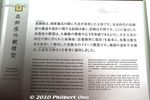
About the Takamikura Throne in English.
|
|

Takamikura Throne
|
|

This thing is so nice that they should get a real emperor's coronation or enthronement here someday.
|
|

Takamikura Throne where the emperor sat when there was an audience.
|
|

Top of the Takamikura Throne
|
|

Phoenix atop the Takamikura Throne.
|
|

It looks like a portable shrine.
|
|

Design pattern on the Takamikura Throne panels.
|
|

Behind the Takamikura Throne.
|
|

We could also go outside on the balcony and see a good view.
|
|

They had a large stage out front on the day I visited and these ribbons attached to the building.
|
|

The Daigokuden Hall's front gate, called Suzaku Gate, can be seen.
|
|

Life-size model of the Shibi ornament atop the roof's ridge.
|
|

The ceiling has hand-painted flowers.
|
|

Paintings on the ceiling.
|
|

Paintings on the ceiling.
|
|

Roof tile used in the reconstruction.
|
|

Metal fittings on a door.
|
|

Balcony railing.
|
|

Metal fitting and ornament on balcony railing and decorative jewel ball in blue.
|
|

On the railing are decorative jewel balls in different colors.
|
|

Exit of Daigokuden Hall.
|
|

Roof edges.
|
|

Roof edges of Daigokuden Hall.
|
|
|
|

If there's something you have to see here, it's this building.
|
|
|

Former Imperial Audience Hall.
|
|

Daigokuden Former Imperial Audience Hall, Heijo-kyo, Nara
|
|
|

The plaza in front of the Former Imperial Audience Hall is quite large.
|
|
|
|
|

At 1 pm in front of the South Gate, the Heijo Palace guards (Ejitai) reenact a guard routine. They appear three times a day. 衛士隊
|
|

A few of the guards were female.
|
|

衛士隊の再現(南門広場)
|
|
|
|

Twice a day, the colorful Aoni-yoshi Parade is held for 30 min. in front of the South Gate. 平城遷都1300年祭 あをによしパレー
|
|

The Aoniyoshi Parade reflects the Tempyo Period when Japan held exchanges with foreign cultures and when Buddhism was introduced to Japan.
|
|
|
|
|

Aoni-yoshi Parade is a great photo op.
|
|
|

Aoniyoshi Parade at Heijo-kyo, Nara
|
|

Buddhist priests in the Aoniyoshi Parade.
|
|

This is in front of the South Gate.
|
|
|
|

These two represent the many traders from China, Korea, and India doing business in Heijo-kyo.
|
|
|
|

These pictures were taken in early May so the flower motif might change in later seasons.
|
|
|
|
|
|
|

This Aoniyoshi Parade might be canceled in the event of rain.
|
|
|

A maze of flowers. On the right in the background is the Mahoroba Stage.
|
|

Flower maze.
|
|

Rest station. This place had cooling vapors as well.
|
|

At the Mahoroba Stage, the Sento-kun show was held to a full house. (Standing room only.)
|
|

And here's Sento-kun, the official mascot of the 1300th anniversary of the Heijo-kyo Capital. When he was first introduced a few years ago, some people lambasted the design as insulting to priests.
|
|

Deer antlers on the head of a boy priest was funny. But he has proven to be a major hit among the masses and critics are silent now. The deer antlers come from the famous deer of Nara Park where they wander around with tourists.
|
|

Sento-kun first made various poses for picture-taking by the audience.
|
|

"Sento" means "Capital relocation" in this case, and not public bath. Japan's capital was relocated to Nara Heijo-kyo in 710, 1,300 years ago.
|
|
|
|

Sento-kun also danced to his silly-sounding theme song. Also see my video at YouTube.
|
|

Bus terminal at the Entrance Plaza. The free shuttle buses can take you to both JR and Kintetsu Nara Station.
|
|

Next to the bus stop is the Entrance Plaza, the site's main entrance. The Food Court is here too, as well as souvenir shops. エントランス広場
|
|

Where to get a tour guide for foreigners. The guided tour is free if you show a foreign passport.
|
|

Suzaku Gate is the other prominent landmark at the Heijo-kyo site.
|
|

Suzaku Gate 朱雀門
|
|

Back of Suzaku Gate.
|
|

Front of Suzaku Gate.
|
|

Daigokuden Hall as seen from Suzaku Gate.
|
|

The Heijo-kyo History Museum is near the Entrance Plaza. 平城京歴史館
|
|

The Heijo-kyo History Museum includes a full-scale replica of the ship used to transport Japanese envoys to and from Tang China during the Nara Period. 平城京歴史館/遣唐使船復原展示
|
|

When it's crowded (weekends, etc.), they require reservation tickets (seiriken) to enter the museum. The seiriken can be had near the museum. Museum admission is 500 yen, but free if you show a foreign passport..
|
|

About the ship to China in English.
|
|

Aboard the diplomatic ship to Tang China. It's pretty small.
|
|
|
|

The compartment toward the front was the envoy's quarters.
|
|
|

Ship's rudder
|
|

Mast
|
|

View of Entrance Plaza from the ship. The museum (photography not allowed inside) has animated films and panel displays.
|
|

These platforms are the site of old buildings.
|
|

These pillar-like bushes indicate the location of pillars of buildings which existed in the Heijo Palace.
|
|

Another museum you should see is this Excavation Site Exhibition Hall. Free admission. 遺構展示館
|
|

About the Excavation Site Exhibition Hall in English.
|
|

Display of a model of the emperor's residence (Imperial Domicile).
|
|

Model of the Imperial Domicile.
|
|
|

About the Imperial Domicile.
|
|
|
|
|

Wooden well
|
|
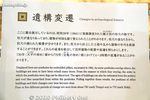
About the excavated pillar holes in English.
|
|

Pillar post holes which were excavated here. 遺構展示館
|
|
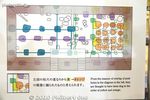
Layout of the excavated pillar holes.
|
|

Overlapping pillar holes. The hole was reused.
|
|

Roof tile pieces.
|
|
|

Pottery
|
|
|
|
|

Gate to the Office of the Imperial Household.
|
|

Office of the Imperial Household, a government agency looking after the Imperial family.
|
|
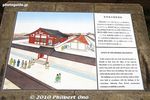
About the Office of the Imperial Household in English.
|
|
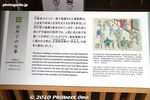
About the Office of the Imperial Household.
|
|

Chairs and desks on a dirt floor.
|
|
|

Desks for writing on mokkan wooden tablets since using paper was too precious in those days.
|
|

Hands-on Learning Center 体験楽習広場
|
|

Cooling mists at Hands-on Learning Center.
|
|

At the Hands-on Learning Center, kids can try their hand at archeological digging in this sand box. They don't get to keep what they find. Reservations required.
|
|

Pottery workshop
|
|

Photo studio where you can dress up in Tempyo Period costumes and get your picture taken.
|
|

This is not a restaurant. It's where you can try writing on wooden tablets. Inside the Hands-on Learning Center.
|
|
|

Flower arrangement for a Man'yoshu poem.
|
|

The museums can be quite far apart within the Heijo-kyo site. Walking can be tiring.
|
|

That's why they have a tram. ハートフルトラム
|
|

Straight ahead is the entrance to the Eastern Palace Garden.
|
|

Flowers in spring.
|
|

Eastern Palace Garden 東院庭園広場
|
|

Eastern Palace Garden
|
|
|
|
|
|
|
|

A strange sight.
|
|

This area is still being excavated so it's off limits.
|
|

As you can see, the place is quite spread out. Be prepared to do some walking if you want to see things.
|
|

Azalea and Suzaku Gate.
|
|

Directional sign in English.
|
|

On the day I went (May 9) during Golden Week, they held the Tempyo Gyoretsu Procession featuring 1,300 people in Tempyo (Tenpyo) Period (729-749) costumes.
|
|

Unfortunately, they did not have any signs for each group of people in the parade so I can't identify who's who and what's what.
|
|

There was an MC introducing the people in the parade, but there was a time lag. These people are Gigaku mime performers. It's now a lost art from the 7th-8th centuries.
|
|

Gigaku performers wore these large, wooden masks. These gigaku masks depict Chinese women. 伎楽
|
|
|

Gigaku performer.
|
|

These Gigaku performers ere played by Tenri University's Gagaku Club student members.
|
|

Gigaku performers performed during Buddhist ceremonies. Although it got quite popular, it eventually died out.
|
|
|
|

Tempyo Procession, Nara Heijo-kyo
|
|
|
|
|
|
|
|
|
|
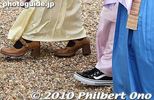
I finally realized what was wrong. Their footwear didn't match the period.
|
|
|
|
|
|
|
|
|
|
|
|
|

Biwa player
|
|

Sacred music
|
|
|
|
|
|
|

Sento-kun's cousins.
|
|

Hello!
|
|

Bird gigaku mask is quite famous.
|
|
|
|
|

Pretty little princess
|
|
|

Korean contingent (drummers)
|
|

Korean women
|
|
|
|

Koreans
|
|
|
|

Mountain ascetic priests.
|
|

The end of the procession featured Buddhist priests of all sects.
|
|

There were many of them in Tempyo Procession, Nara Heijo-kyo.
|
|
|

Women Buddhist priests.
|
|
|
|
|

Heading for the stage.
|
|

Because of this parade, I didn't have time to see everything at this site. Maybe next time, in which I case I shall update this page with more photos.
|
|

A lot of people sat.
|
|

Lots of empty chairs went to waste.
|
|

On stage, the Buddhist and Shinto priests held a prayer for peace. I didn't stick around for this.
|
|

The Heijo Palace guard (Ejitai) holds the Gate-closing ceremony at the end of the day at Suzaku Gate at 5:10 pm. 衛士隊
|
|

This is the front of Suzaku Gate. Later they will go through the doors to the other side and close the doors. 朱雀門広場
|
|
|

The close the gate doors.
|
|

They also open the gate doors every morning. The ceremony might be cancelled if it rains.
|
|
|

The Heijo Palace guard (Ejitai) holds the Gate-closing ceremony at the end of the day at Suzaku Gate.
|
|

The Palace guard completes its job and I caught the last shuttle bus back to Nara Station at 6 pm.
|
|
|
|
|
|
|